 W
WA pole weapon or pole arm is a close combat weapon in which the main fighting part of the weapon is fitted to the end of a long shaft, typically of wood, thereby extending the user's effective range and striking power. Pole weapons are predominantly melee weapons, with a subclass of spear-like designs fit for both thrusting and throwing. Because many pole weapons were adapted from agricultural implements or other tools in fairly large amount of abundance, and contain relatively little metal, they were cheap to make and readily available. When warfare breaks out and the belligerents have a poorer class who cannot pay for dedicated weapons made for war, military leaders often resort to the appropriation of tools as cheap weapons. The cost of training was minimal, since these conscripted farmers had spent most of their lives in the familiar use of these "weapons" in the fields. This made polearms the favored weapon of peasant levies and peasant rebellions the world over.
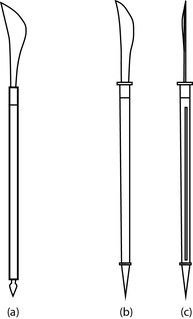 W
WAn Arbir is an Indonesian weapon, a halberd, approximately five feet long.
 W
WBarsha or barcha is a type of lance with a wooden handle, once common in South Asia. They were common in the 16th century.
 W
WA bear spear was a medieval type of spear used in hunting for bears and other large animals. The sharpened head of a bear spear was enlarged and usually took the form of a bay leaf. Right under the head there was a short crosspiece that helped fix the spear in the body of an animal and keep it at a distance from the hunter.
 W
WBedil tombak or bedil tumbak is a type of early firearm from the Nusantara archipelago. The weapon consist of a gun or small cannon mounted on a wooden pole, forming a type of weapon known as "pole gun".
 W
WThe three most common types of Chinese polearms are the ge (戈), qiang (槍), and ji (戟). They are translated into English as dagger-axe, spear, and halberd. Dagger-axes were originally a short slashing weapon with a 0.9 to 1.8 m long shaft, but around the 4th century BC a spearhead was added to the blade, and it became a halberd. The spear is also sometimes called a mao (矛), which is sometimes used to designate polearms with a wavy snake-like spearhead. There was another polearm weapon known as the pi (鈹), translated into English as either sword-staff or long lance, that was used from ancient times until the Han dynasty. It was essentially a short sword attached to a stick. From the Warring States period onward, the length of Chinese polearms varied from around 2.8 m to 5.5 m, however there is no specific designation for a pike in the traditional Chinese lexicon. A very long spear is just called a long spear.
 W
WThe corseque is a type of European pole weapon, characterised by a three-lobe blade on a 1.8 to 2.5-metre shaft. The head features a long spike and two shorter and stronger lateral blades.
 W
WDangpa, or dang pa, is the Korean name for a Ranseur first described in the Muyejebo, a Korean martial arts manual of the Joseon Dynasty.
 W
WThe falx was a weapon with a curved blade that was sharp on the inside edge used by the Thracians and Dacians – and, later, a siege hook used by the Romans.
 W
WA fauchard is a type of polearm weapon which was used in Europe from the 11th through the 17th centuries. In later use fauchards became ornamental and ceremonial, growing in size until some examples were almost too heavy to carry, let alone use. The design consisted of a curved blade atop a long pole, although in some portrayals, it is shown on a shorter pole. The blade bore a moderate to strong curve along its length. The cutting edge was only on the convex side of the blade, unlike the guisarme or bill. The fauchard was likely developed from the war scythe with the cutting edge turned opposite, convex instead of concave, so that the weapon was good for both thrusting and slashing attacks.
 W
WThe gichang is a Korean weapon which is first described in the Muyesinbo, a Korean martial arts manual published in 1759. It later also found its way into the Muyedobotongji (1791).
 W
WA glaive is a European polearm, consisting of a single-edged blade on the end of a pole. It is similar to the Japanese naginata, the Chinese guandao and pudao, the Korean woldo, the Russian sovnya, and the Siberian palma.
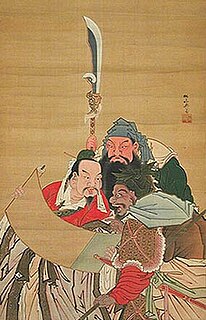 W
WA guandao is a type of Chinese pole weapon that is used in some forms of Chinese martial arts. In Chinese, it is properly called a yanyuedao, the name under which it always appears in texts from the Song to Qing dynasties such as the Wujing Zongyao and Huangchao Liqi Tushi. It is comparable to the Japanese naginata and the European fauchard or glaive and consists of a heavy blade with a spike at the back and sometimes also a notch at the spike's upper base that can catch an opponent's weapon. In addition there are often irregular serrations that lead the back edge of the blade to the spike. The blade is mounted atop a 1.5 m to 1.8 m (5–6 foot) long wooden or metal pole with a pointed metal counter weight used to balance the heavy blade and for striking on the opposite end.
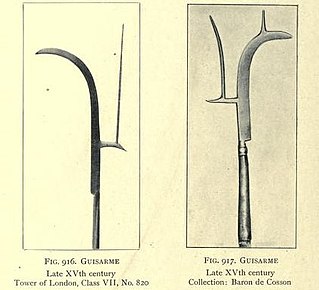 W
WA guisarme is a pole weapon used in Europe primarily between 1000 and 1400. Its origin is likely Germanic, from the Old High German getīsarn, literally "weeding iron". Like many medieval polearms, the exact early form of the weapon is hard to define from literary references, and the identification of surviving weapons can be speculative.
 W
WA gun is a long Chinese staff weapon used in Chinese martial arts. It is known as one of the four major weapons, along with the qiang (spear), dao (sabre), and the jian. It is called, in this group, "The Grandfather of all Weapons". In Vietnam, the gun is known as Côn in Vietnamese martial arts.
 W
WA halberd is a two-handed pole weapon that came to prominent use during the 14th, 15th, and 16th centuries. The word halberd is most likely equivalent to the German word Hellebarde, deriving from Middle High German halm (handle) and barte (battleaxe) joined to form helmbarte. Troops that used the weapon were called halberdiers.
 W
WThe horseman's pick was a weapon of Middle Eastern origin used by cavalry during the Middle Ages in Europe and the Middle East. This was a type of war hammer that had a very long spike on the reverse of the hammer head. Usually, this spike was slightly curved downwards, much like a miner's pickaxe. The term is sometimes used interchangeably with war hammer. A metal-made horseman's pick called "nadziak" was one of the main weapons of the famous Polish Winged Hussars. A weapon of late make, the horseman's pick was developed by the English and used by their heavy Billmen, a unit of heavy infantry. It was used with great success during the Hundred Years' War. A use of the horseman's pick was to tear men from their mounts.
 W
WThe Jangchang, literally long spear, is a Korean weapon first described in the 16th century martial arts manual, Muyejebo. The weapon was preferably made from the wood of the yew tree, but other types of wood could be used as well, such as oak and chestnut.
 W
WThe ji was a Chinese polearm, often translated into English as spear or halberd, though they are fundamentally different weapons. They were used in one form or another for over 3000 years, from at least as early as the Zhou dynasty, until the end of the Qing dynasty. They are still used for training purposes in many Chinese martial arts.
 W
WThe jukjangchang, literally bamboo long spear, is a Korean weapon.
 W
WThe kontos was the Greek name for a type of long wooden cavalry lance used by the Iranians, especially Achaemenid successors' cavalry, most notably cataphracts (Grivpanvar). It was also used by the Germanic warriors of the south as a pike. A shift in the terminology used to describe Sarmatian weapons indicates the kontos was developed in the early to mid 1st century AD from shorter spear-type weapons, though such a description may have existed before the Battle of Carrhae, in which Parthian cataphracts, in conjunction with light horse archers, annihilated a Roman army of over three times their numbers.
 W
WThe langxian was a branched, multi-tipped spear with blades attached to the branches. The blades could be dipped in poison. The langxian was a weapon well suited for defense, as it would be difficult for an opponent to assault the wielder without risking contact with the blades.
 W
WThe Lochaber axe is a type of poleaxe that was used almost exclusively in Scotland. It was usually mounted on a staff about five feet long.
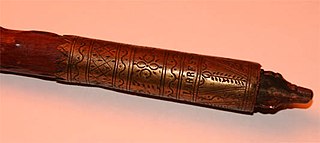 W
WThe makila is a traditional Basque walking stick, and is notable as both a practical tool and a cultural symbol of authority and strength.
 W
WA man catcher, also known as catchpole, is an esoteric type of pole weapon which was used in Europe as late as the 18th century. It consisted of a pole mounted with a two pronged head. Each prong was semi-circular in shape with a spring-loaded "door" on the front. This created an effective valve that would allow the ring to pass around a man-sized cylinder and keep it trapped. The man catcher was used primarily to pull a person from horseback and drag him to the ground where he could be helplessly pinned. This is one of the few examples of less-lethal polearms.
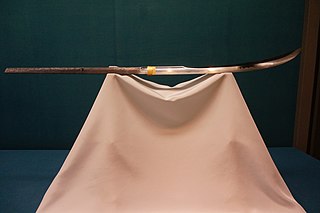 W
WThe naginata is a pole weapon and one of several varieties of traditionally made Japanese blades (nihonto). Naginata were originally used by the samurai class of feudal Japan, as well as by ashigaru and sōhei. The naginata is the iconic weapon of the onna-bugeisha, a type of female warrior belonging to the Japanese nobility.
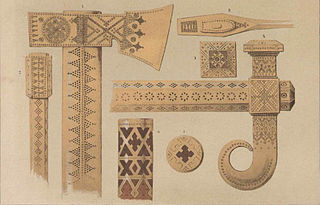 W
WObuch, Obuszek or Obushysko – Is a type of Melee weapon, very similar to a Horseman's pick but differing from it with a curved beak opposite the hammer.
 W
WAn ōtsuchi is a large wooden war mallet used by the samurai class of feudal Japan. The ōtsuchi had a shaft of about 6 feet (1.8 m) much like the ono. It was mainly used for door breaching.
 W
WA partisan is a type of polearm that was used in Europe in the 16th, 17th, and 18th century. It consisted of a spearhead mounted on a long shaft, usually wooden, with protrusions on the sides which aided in parrying sword thrusts. Like the halberd, it quickly became obsolete with the arrival of practical firearms, although it stayed in use for many years as a ceremonial weapon. In profile, the head of a partisan may look similar to that of a ranseur, spontoon, ox tongue, or spetum; however, unlike a ranseur, the lower parts of the head have a sharpened edge.
 W
WA pike is a pole weapon, a very long thrusting spear formerly used extensively by infantry. Pikes were used regularly in European warfare from the Late Middle Ages to the early 18th century, and were wielded by foot soldiers deployed in close quarters, until it was replaced by rifles, which had a longer range, and to which a bayonet could be attached. The pike found extensive use with Landsknecht armies and Swiss mercenaries, who employed it as their main weapon and used it in pike square formations. A similar weapon, the sarissa, was also used by Alexander the Great's Macedonian phalanx infantry to great effect. Generally, a spear becomes a pike when it is too long to be wielded with one hand in combat.
 W
WPike poles are long metal-topped wood, aluminum, or fiberglass poles used for reaching, holding, or pulling. They are variously used in construction, logging, rescue and recovery, power line maintenance, and firefighting.
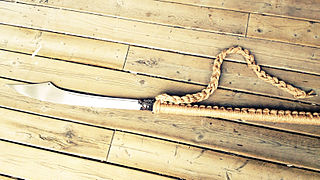 W
WPodao or pudao is a Chinese single-edged infantry weapon which is still used primarily for training in various Chinese martial arts. The blade of the weapon is shaped like a Chinese broadsword, but the weapon has a longer handle, usually around one to two meters which is circular in cross section. It looks somewhat similar to the guandao.
 W
WA quarterstaff, also short staff or simply staff is a traditional European pole weapon, which was especially prominent in England during the Early Modern period.
 W
WA ranseur, also called roncone, was a pole weapon similar to the partisan used in Europe up to the 15th century. It was still seen in court as a ceremonial weapon through the 17th century.
 W
WThe rhomphaia was a close-combat bladed weapon used by the Thracians as early as 350-400 BC. Rhomphaias were weapons with a straight or slightly curved single-edged blade attached to a pole, which in most cases was considerably shorter than the blade. Although the rhomphaia was similar to the falx, most archaeological evidence suggests that rhomphaias were forged with straight or slightly curved blades, presumably to enable their use as both a thrusting and slashing weapon. The blade was constructed of iron and used a triangular cross section to accommodate the single cutting edge with a tang of rectangular cross section. Length varied, but a typical rhomphaia would have a blade of approximately 60–80 cm and a tang of approximately 50 cm. From the length of the tang, it can be presumed that, when attached to the hilt, this portion of the weapon would be of similar length to the blade.
 W
WThe sarisa or sarissa was a long spear or pike about 4–6 metres (13–20 ft) in length. It was introduced by Philip II of Macedon and was used in his Macedonian phalanxes as a replacement for the earlier dory, which was considerably shorter. These longer spears improved the strength of the phalanx by extending the rows of overlapping weapons projecting towards the enemy, and the word remained in use throughout the Byzantine years to sometimes describe the long spears of their own infantry.
 W
WMany of the polearms used in Scotland up to the beginning of the 16th century were similar to those used in other parts of the world; however, a number of distinct forms did evolve. The nomenclature of Scottish axes, in particular, is confusing, and the text below follows the classification scheme proposed by David H. Caldwell in his 1980 paper "Some Notes on Scottish Axes and Long Shafted Weapons".
 W
WSibat is the Filipino word for spear, used as a weapon or tool by natives of the Philippines. The term is used in Tagalog and Kinaray-a. It also called bangkaw, sumbling or palupad in the islands of Visayas and Mindanao; and budjak among Muslim Filipinos in western Mindanao and the Sulu Archipelago.
 W
WA spetum is a pole weapon that was used in Europe during the 13th century. It consists of a pole, some 6–8 feet long, on which is mounted a spear head with two projections at its base. Many variations of this design flourished over time; some feel that the ranseur is a variation of the spetum. Other names include chauve souris, corseca, corsèsque, korseke, runka, and rawcon. The spetum is usually distinguished from the ranseur and partisan by its "prongs" being single edged and used for slashing. The main blade is 12–14 inches long, and the side blades are only about half that length and are set at acute angles.
 W
WA taiaha is a traditional weapon of the Māori of New Zealand; a close-quarters staff weapon made from either wood or whalebone, and used for short, sharp strikes or stabbing thrusts with efficient footwork on the part of the wielder.
 W
WA tewhatewha is a long-handled Māori club weapon shaped like an axe. Designed to be held in two hands, the weapon comes to a mata (point) at one end and a rapa at the other.
 W
WThe three-section staff, triple staff, three-part staff, sansetsukon in Japanese, or originally sanjiegun, is a Chinese flail weapon that consists of three wooden or metal staffs connected by metal rings or rope. The weapon is also known as 蟠龍棍 panlong gun, "coiling dragon staff". A more complicated version of the two section staff, the staves can be spun to gather momentum resulting in a powerful strike, or their articulation can be used to strike over or around a shield or other defense.
 W
WA voulge is a type of polearm that existed alongside the similar glaive in medieval Europe. Superficially, a voulge might strongly resemble a glaive, but there are some notable differences in construction. First, the attachment of the voulge blade to the shaft was usually done by binding the lower two thirds of the blade to the side of the pole; the glaive would often have a socket built into the blade itself and was mounted on top of the pole. In addition, while both had curved blades, that of the voulge was broad and meant for hacking, while that of the glaive was narrow and meant more for cutting. A voulge thus looks something like a squashed bardiche, or just a meat cleaver attached to a long pole. Troops that used the weapon are called voulgiers.
 W
WA war scythe or military scythe is a form of pole weapon with a curving single-edged blade with the cutting edge on the concave side of the blade. Its blade bears some superficial resemblance to that of an agricultural scythe from which it likely evolved, but the war scythe is otherwise unrelated to agricultural tools and is a purpose-built infantry melee weapon. The blade of a war scythe has regularly proportioned flats, a thickness comparable to that of a spear or sword blade, and slightly curves along its edge as it tapers to its point. This is very different from farming scythes, which have very thin and irregularly curved blades, specialised for mowing grass and wheat only, unsuitable as blades for improvised spears or polearms.
 W
WThe woldo, was a Korean pole weapon that closely resembled the Chinese guandao, though proportionally smaller. It was so named because of its curved blade. Its use and its methods were described in the Muyedobotongji, which was published in 1795.
 W
WThe xyston, a derivative of the verb ξύω "scrape, shave", was a type of a long thrusting spear in ancient Greece. It measured about 3.5–4.25 meters (11.5–13.9 ft) long and was probably held by the cavalryman with both hands, although the depiction of Alexander the Great's xyston on the Alexander Mosaic in Pompeii, suggests that it could also be used single handed. It had a wooden shaft and a spear-point at both ends. Possible reasons for the secondary spear-tip were that it acted partly as a counterweight and also served as a backup in case the xyston was broken in action. The xyston is usually mentioned in context with the hetairoi (ἑταῖροι), the cavalry forces of ancient Macedon. After Alexander the Great's death, the hetairoi were named xystophoroi because of their use of the xyston lance. In his Greek-written Bellum Judaicum, the Jewish historian Flavius Josephus uses the term xyston to describe the Roman throwing javelin, the pilum.